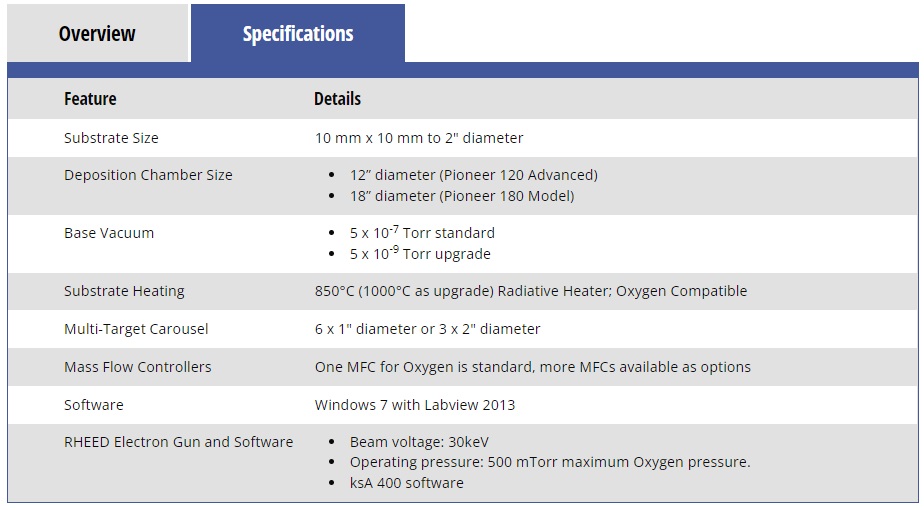Product
 Home> Product >Vacuums>Neocera
Home> Product >Vacuums>Neocera





Neocera
Pioneer 180 Laser MBE/PLD System
UHV-PLD systems integrated with Reflection High-Energy Electron Diffraction (RHEED) diagnostics are also known as Laser MBE systems. These systems are used for creating high-quality epitaxial films and novel interfaces with exceptional film growth-control at the atomic level as has been done conventionally in Molecular Beam Epitaxy (MBE) Systems.
In RHEED, a high energy (20-30 keV) electron beam is incident on the film growth surface at a glancing angle of ~2˚-5˚. The diffraction pattern created on a screen contains information about the crystal structure of the film, stress at the interface, possible impurity phases etc and can be used for real-time monitoring of the film quality. The RHEED oscillations, where the RHEED specular spot intensity is monitored as a function of deposition time provides information on the deposition rate as well as information on the growth mode (2D vs 3D) of the deposited film. A high quality 2D layer-by-layer growth mode is inferred by the observed RHEED intensity oscillations extending to several cycles. Double differential pumping of the RHEED source facilitates high-pressure operation up to about 500mTorr, facilitating real-time moni-toring of complex oxide film growth at high oxygen pressures.
Neocera Laser MBE systems include custom designs such as UHV compatible Laser Substrate Heaters that facilitate integration of Laser MBE systems with insitu Analytical Systems like XPS/ARPES etc. The samples are easily transferred from Laser MBE/ PLD System to XPS/ARPES Systems in UHV.
In RHEED, a high energy (20-30 keV) electron beam is incident on the film growth surface at a glancing angle of ~2˚-5˚. The diffraction pattern created on a screen contains information about the crystal structure of the film, stress at the interface, possible impurity phases etc and can be used for real-time monitoring of the film quality. The RHEED oscillations, where the RHEED specular spot intensity is monitored as a function of deposition time provides information on the deposition rate as well as information on the growth mode (2D vs 3D) of the deposited film. A high quality 2D layer-by-layer growth mode is inferred by the observed RHEED intensity oscillations extending to several cycles. Double differential pumping of the RHEED source facilitates high-pressure operation up to about 500mTorr, facilitating real-time moni-toring of complex oxide film growth at high oxygen pressures.
Neocera Laser MBE systems include custom designs such as UHV compatible Laser Substrate Heaters that facilitate integration of Laser MBE systems with insitu Analytical Systems like XPS/ARPES etc. The samples are easily transferred from Laser MBE/ PLD System to XPS/ARPES Systems in UHV.





